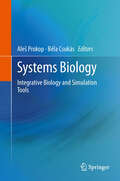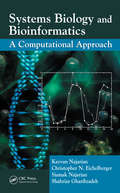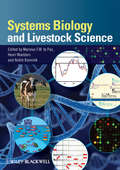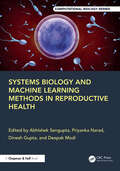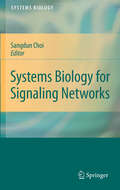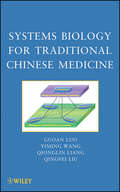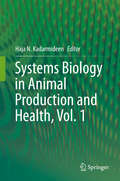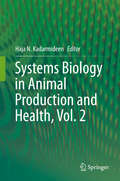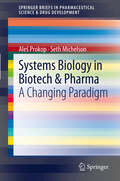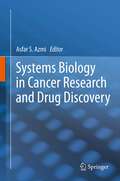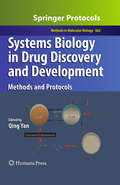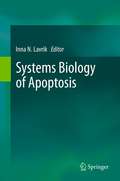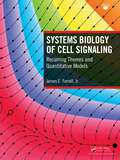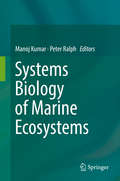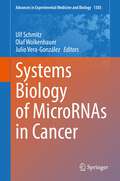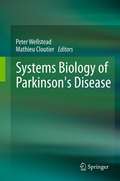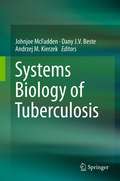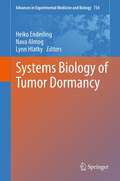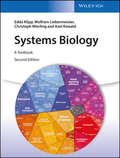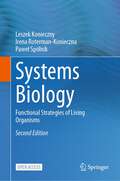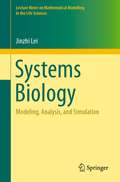- Table View
- List View
Systems Biology Volume 1: Integrative Biology and Simulation Tools
by Aleš Prokop Bela CsukasGrowth in the pharmaceutical market has slowed down - almost to a standstill. One reason is that governments and other payers are cutting costs in a faltering world economy. But a more fundamental problem is the failure of major companies to discover, develop and market new drugs. Major drugs losing patent protection or being withdrawn from the market are simply not being replaced by new therapies - the pharmaceutical market model is no longer functioning effectively and most pharmaceutical companies are failing to produce the innovation needed for success. This multi-authored new book looks at a vital strategy which can bring innovation to a market in need of new ideas and new products: Systems Biology (SB). Modeling is a significant task of systems biology. SB aims to develop and use efficient algorithms, data structures, visualization and communication tools to orchestrate the integration of large quantities of biological data with the goal of computer modeling. It involves the use of computer simulations of biological systems, such as the networks of metabolites comprise signal transduction pathways and gene regulatory networks to both analyze and visualize the complex connections of these cellular processes. SB involves a series of operational protocols used for performing research, namely a cycle composed of theoretical, analytic or computational modeling to propose specific testable hypotheses about a biological system, experimental validation, and then using the newly acquired quantitative description of cells or cell processes to refine the computational model or theory.
Systems Biology and Bioinformatics: A Computational Approach
by Kayvan Najarian Siamak Najarian Shahriar Gharibzadeh Christopher N. EichelbergerThe availability of molecular imaging and measurement systems enables today's biologists to swiftly monitor thousands of genes involved in a host of diseases, a critical factor in specialized drug development. Systems Biology and Bioinformatics: A Computational Approach provides students with a comprehensive collection of the computational methods
Systems Biology and Livestock Science
by Marinus F.W. te PasSystems Biology is an interdisciplinary approach to the study of life made possible through the explosion of molecular data made available through the genome revolution and the simultaneous development of computational technologies that allow us to interpret these large data sets. Systems Biology has changed the way biological science views and studies life and has been implemented in research efforts across the biological sciences. Systems Biology and Livestock Science will be the first book to review the latest advances using this research methodology in efforts to improve the efficiency, health, and quality of livestock production. Systems Biology and Livestock Science opens with useful introductory chapters explaining key systems biology principles. The chapters then progress to look at specific advances in fields across livestock science. Coverage includes, but is not limited to, chapters on systems biology approaches to animal nutrition, reproduction, health and disease, and animal physiology. Written by leading researchers in the field, Systems Biology and Livestock Science, will be an invaluable resource to researchers, professionals, and advance students working in this rapidly developing discipline.
Systems Biology and Machine Learning Methods in Reproductive Health (Chapman & Hall/CRC Computational Biology Series)
by Dinesh Gupta Abhishek Sengupta Priyanka Narad Deepak ModiSystems Biology and Machine Learning Methods in Reproductive Health is an innovative and wide-ranging book that discovers the synergetic combination of disciplines: systems biology and machine learning, with an application in the field of reproductive health. This book assembles the expertise of leading scientists and clinicians to present a compilation of cutting-edge techniques and case studies utilizing computational methods to elucidate intricate biological systems, elucidate reproductive pathways, and address critical issues in the fields of fertility, pregnancy, and reproductive disorders. Bringing science and data science together, this groundbreaking book provides scientists, clinicians, and students with a step-by-step guide to uncovering the complexities of reproductive health through cutting-edge computational tools.
Systems Biology for Signaling Networks
by Sangdun ChoiSystem Biology encompasses the knowledge from diverse fields such as Molecular Biology, Immunology, Genetics, Computational Biology, Mathematical Biology, etc. not only to address key questions that are not answerable by individual fields alone, but also to help in our understanding of the complexities of biological systems. Whole genome expression studies have provided us the means of studying the expression of thousands of genes under a particular condition and this technique had been widely used to find out the role of key macromolecules that are involved in biological signaling pathways. However, making sense of the underlying complexity is only possible if we interconnect various signaling pathways into human and computer readable network maps. These maps can then be used to classify and study individual components involved in a particular phenomenon. Apart from transcriptomics, several individual gene studies have resulted in adding to our knowledge of key components that are involved in a signaling pathway. It therefore becomes imperative to take into account of these studies also, while constructing our network maps to highlight the interconnectedness of the entire signaling pathways and the role of that particular individual protein in the pathway. This collection of articles will contain a collection of pioneering work done by scientists working in regulatory signaling networks and the use of large scale gene expression and omics data. The distinctive features of this book would be: Act a single source of information to understand the various components of different signaling network (roadmap of biochemical pathways, the nature of a molecule of interest in a particular pathway, etc.), Serve as a platform to highlight the key findings in this highly volatile and evolving field, and Provide answers to various techniques both related to microarray and cell signaling to the readers.
Systems Biology for Traditional Chinese Medicine
by Qionglin Liang Yiming Wang Qingfei Liu Guoan LuoThe application of systems biology methods to Traditional Chinese MedicineEmphasizing the harmony of the human body with the environment, Traditional Chinese Medicine (TCM) has evolved over thousands of years. It is a systemic theory derived from clinical experience, the philosophy of holism and systematology, and the belief that man is an integral part of nature.Systems Biology for Traditional Chinese Medicine describes how the latest methods in systems biology can be applied to TCM, providing a comprehensive resource for the modernization and advancement of TCM as well as general drug discovery efforts. It is the first comprehensive work to propose a system-to-system research methodology to study the interaction between TCM and the human body and its applications in drug research and development.Using three popular traditional Chinese medicines--Shuanglongfang, Qingkailing, and Liushenwan--as examples, the authors set forth case examples demonstrating how to find material groups, perform efficacy screenings, and conduct safety evaluations of TCM. The book also:Describes the mechanisms of TCM at the molecular and systems levels using chemomics, genomics, proteomics, metabolomics, and bioinformaticsPlaces modern scientific technologies within the context of TCM, helping drug researchers improve experimental designs and strategiesIllustrates how a systems biology approach is compatible with TCM's traditional, holistic therapeutic strategies and treatment modalitiesPresents topics of current interest, such as integrated global systems biology and the application of chemometrics research to herbal medicinesThis book not only opens a new pathway for the continued development of TCM, but also for systems biology. In addition, it fosters collaboration and discussion among Eastern and Western scientists by applying systems biology to TCM.
Systems Biology in Animal Production and Health, Vol. 1
by Haja N. KadarmideenThis two-volume work provides an overview on various state of the art experimental and statistical methods, modeling approaches and software tools that are available to generate, integrate and analyze multi-omics datasets in order to detect biomarkers, genetic markers and potential causal genes for improved animal production and health. The book will contain online resources where additional data and programs can be accessed. Some chapters also come with computer programming codes and example datasets to provide readers hands-on (computer) exercises. This first volume presents the basic principles and concepts of systems biology with theoretical foundations including genetic, co-expression and metabolic networks. It will introduce to multi omics components of systems biology from genomics, through transcriptomics, proteomics to metabolomics. In addition it will highlight statistical methods and (bioinformatic) tools available to model and analyse these data sets along with phenotypes in animal production and health. This book is suitable for both students and teachers in animal sciences and veterinary medicine as well as to researchers in this discipline.
Systems Biology in Animal Production and Health, Vol. 2
by Haja N. KadarmideenThis two-volume work provides an overview on various state of the art experimental and statistical methods, modeling approaches and software tools that are available to generate, integrate and analyze multi-omics datasets in order to detect biomarkers, genetic markers and potential causal genes for improved animal production and health. The book will contain online resources where additional data and programs can be accessed. Some chapters also come with computer programming codes and example datasets to provide readers hands-on (computer) exercises. This second volume deals with integrated modeling and analyses of multi-omics datasets from theoretical and computational approaches and presents their applications in animal production and health as well as veterinary medicine to improve diagnosis, prevention and treatment of animal diseases. This book is suitable for both students and teachers in animal sciences and veterinary medicine as well as to researchers in this discipline.
Systems Biology in Biotech & Pharma
by Seth Michelson Aleš ProkopThe US is currently well ahead of the rest of the world in the development and application of SB and its principles especially as they pertain to basic medical research and development. This lead is largely due to its earlier start in the academic arena. However, there is evidence of rapid development in both the UK/EU and Japan, and the gap is narrowing, particularly in the UK. From an industrial point of view, the Pharmaceutical Industry based in the US and UK can capitalize on these opportunities and gain the benefits of this technology. Many educational institutions (particularly their medical divisions) at present are heavily business-oriented, realize that in this particular industrial environment, that every dollar counts.
Systems Biology in Cancer Research and Drug Discovery
by Asfar S AzmiSystems Biology in Cancer Research and Drug Discovery provides a unique collection of chapters, by world-class researchers, describing the use of integrated systems biology and network modeling in the cancer field where traditional tools have failed to deliver expected promise. This book touches four applications/aspects of systems biology (i) in understanding aberrant signaling in cancer (ii) in identifying biomarkers and prognostic markers especially focused on angiogenesis pathways (iii) in unwinding microRNAs complexity and (iv) in anticancer drug discovery and in clinical trial design. This book reviews the state-of-the-art knowledge and touches upon cutting edge newer and improved applications especially in the area of network modeling. It is aimed at an audience ranging from students, academics, basic researcher and clinicians in cancer research. This book is expected to benefit the field of translational cancer medicine by bridging the gap between basic researchers, computational biologists and clinicians who have one ultimate goal and that is to defeat cancer.
Systems Biology in Drug Discovery and Development: Methods and Protocols
by Qing YanDue to the failing "one-drug-fits-all" model, it has become increasingly necessary to develop personalized medicine that treats whole systems and brings the right drug to the right patient with the right dosages. In Systems Biology in Drug Discovery and Development: Methods and Protocols, leading experts provide a practical, state-of-the-art, and holistic view of the translation of systems biology into better drug discovery and personalized medical practice. While the first part of the book describes cutting-edge technologies and methods in the field, the second part illustrates how the technologies can be applied in science for disease understanding and therapeutic discovery. As a volume in the highly successful Methods in Molecular BiologyTM series, this collection provides the kind of detailed description and implementation advice that is crucial for getting optimal results. Authoritative and up-to-date, Systems Biology in Drug Discovery and Development: Methods and Protocols covers topics from fundamental concepts to advanced technologies in order to best serve biomedical students and professionals at all levels who are interested in vital integrative studies in molecular biology, genetics, bioinformatics, bioengineering, biochemistry, physiology, pathology, microbiology, immunology, pharmacology, toxicology, drug discovery, and clinical medicine.
Systems Biology of Apoptosis
by Inna N. LavrikSystems Biology of Apoptosis summarizes all current achievements in this emerging field. Apoptosis is a process common to all multicellular organisms. Apoptosis leads to the elimination of cells via a complex but highly defined cellular programme. Defects in the regulation of apoptosis result in serious diseases such as cancer, autoimmunity, AIDS and neurodegeneration. Recently, a substantial step forward in understanding the complex apoptotic pathways has been made by utilising systems biology approaches. Systems biology combines rigorous mathematical modelling with experimental approaches in a closed loop cycle for advancing our knowledge about complex biological processes. In this book, the editor describes the contemporary systems biology studies devoted to apoptotic signaling and focuses on the question how systems biology helps to understand life/death decisions made in the cell and to develop new approaches to rational treatment strategies.
Systems Biology of Cell Signaling: Recurring Themes and Quantitative Models
by James FerrellHow can we understand the complexity of genes, RNAs, and proteins and the associated regulatory networks? One approach is to look for recurring types of dynamical behavior. Mathematical models prove to be useful, especially models coming from theories of biochemical reactions such as ordinary differential equation models. Clever, careful experiments test these models and their basis in specific theories. This textbook aims to provide advanced students with the tools and insights needed to carry out studies of signal transduction drawing on modeling, theory, and experimentation. Early chapters summarize the basic building blocks of signaling systems: binding/dissociation, synthesis/destruction, and activation/inactivation. Subsequent chapters introduce various basic circuit devices: amplifiers, stabilizers, pulse generators, switches, stochastic spike generators, and oscillators. All chapters consistently use approaches and concepts from chemical kinetics and nonlinear dynamics, including rate-balance analysis, phase plane analysis, nullclines, linear stability analysis, stable nodes, saddles, unstable nodes, stable and unstable spirals, and bifurcations. This textbook seeks to provide quantitatively inclined biologists and biologically inclined physicists with the tools and insights needed to apply modeling and theory to interesting biological processes.Key Features: Full-color illustration program with diagrams to help illuminate the concepts Enables the reader to apply modeling and theory to the biological processes Further Reading for each chapter High-quality figures available for instructors to download
Systems Biology of Marine Ecosystems
by Manoj Kumar Peter RalphThis book describes the latest advances in systems biology in four plant-based marine ecosystems: seaweeds, seagrasses, microalgae, and corals. Marine organisms that inhabit the oceanic environment experience a diverse range of environmental fluctuations, anthropogenic stress, and threats from invasive species and pathogens. System biology integrates physiology, genomics, transcriptomics, proteomics, and metabolomics into numerical models and is emerging as an important approach to elucidate the functional adaptations of marine organisms to adverse environmental conditions. This book focuses on how ecophysiology, omics platforms, their integration (a systems biology perspective), and next generation sequencing tools are being used to address the stress response of marine seaweeds, seagrasses, corals, marine microbe diversity, and micro-and macroalgae/corals-bacterial interactions to global climate change and anthropogenic activities. The contents of the book are of special interest to graduate and postgraduate marine biology students and marine biology researchers, particularly those interested in marine ecology, stress physiology of marine macrophytes/corals/phytoplankton, and environmental microbiology. This book would also be of interest to marine engineers engaged in the management and conservation of our valuable marine resources.
Systems Biology of Metabolic and Signaling Networks
by Miguel A. Aon Valdur Saks Uwe SchlattnerSystems Biology represents a new paradigm aiming at a whole-organism-level understanding of biological phenomena, emphasizing interconnections and functional interrelationships rather than component parts. The study of network properties, and how they control and regulate behavior from the cellular to organism level, constitutes a main focus of Systems Biology. This book addresses from a novel perspective a major unsolved biological problem: understanding how a cell works and what goes wrong in pathology. The task undertaken by the authors is in equal parts conceptual and methodological, integrative and analytical, experimental and theoretical, qualitative and quantitative, didactic and comprehensive. Essentially, they unravel the spatio-temporal unfolding of interacting mass-energy and information networks at the cellular and organ levels, as well as its modulation through activation or repression by signaling networks to produce a certain phenotype or (patho)physiological response. Starting with the historical roots, in thirteen chapters this work explores the Systems Biology of signaling networks, cellular structures and fluxes, organ and microorganism functions. In doing so, it establishes the basis of a 21st century approach to biological complexity.
Systems Biology of MicroRNAs in Cancer (Advances in Experimental Medicine and Biology #1385)
by Ulf Schmitz Olaf Wolkenhauer Julio Vera-GonzálezThis book provides an update on the latest development in the field of microRNAs in cancer research with an emphasis on translational research. Since the early 2000s, microRNAs have been recognized as important and ubiquitous regulators of gene expression. Soon it became evident that their deregulation can cause human diseases including cancer. This book focuses on the emerging opportunities for the application of microRNA research in clinical practice. In this context, computer models are presented that can help to identify novel biomarkers, e.g. in circulating microRNAs, and tools that can help to design microRNA-based therapeutic interventions. Other chapters evaluate the role of microRNAs in immunotherapy, immune responses and drug resistance. Covering key topics on microRNAs in cancer research this book is a valuable resource for both emerging and established microRNA researchers who want to explore the potential of microRNAs as therapeutic targets or co-adjuvants in cancer therapies.
Systems Biology of Parkinson's Disease
by Mathieu Cloutier Peter WellsteadThe Systems Biology of Parkinson's Disease will be underpinned by new measurement techniques. This is particularly true of the pathology of Parkinson's Disease, where recent developments in brain imaging have offered new insights into the morphology of dopaminergic neurons that have profound implications for the special vulnerability and role of this class of neurons.
Systems Biology of RNA Binding Proteins
by Gene W. YeoAfter transcription in the nucleus, RNA binding proteins (RBPs) recognize cis-regulatory RNA elements within pre-mRNA sequence to form mRNA-protein (mRNP) complexes. Similarly to DNA binding proteins such as transcription factors that regulate gene expression by binding to DNA elements in the promoters of genes, RBPs regulate the fate of target RNAs by interacting with specific sequences or RNA secondary structural features within the transcribed RNA molecule. The set of functional RNA elements recognized by RBPs within target RNAs and which control the temporal, functional and spatial dynamics of the target RNA define a putative "mRNP code". These cis-regulatory RNA elements can be found in the 5' and 3' untranslated regions (UTRs), introns, and exons of all protein-coding genes. RNA elements in 5' and 3' UTRs are frequently involved in targeting RNA to specific cellular compartments, affecting 3' end formation, controlling RNA stability and regulating mRNA translation. RNA elements in introns and exons are known to function as splicing enhancers or silencers during the splicing process from pre-mRNA to mature mRNA. This book provides case studies of RNA binding proteins that regulate aspects of RNA processing that are important for fundamental understanding of diseases and development. Chapters include systems-level perspectives, mechanistic insights into RNA processing and RNA Binding proteins in genetic variation, development and disease. The content focuses on systems biology and genomics of RNA Binding proteins and their relation to human diseases.
Systems Biology of Tuberculosis
by Dany J.V. Beste Johnjoe Mcfadden Andrzej M. KierzekThe book starts with a general introduction into the relevance of systems biology for understanding tuberculosis. This will be followed by several chapters which describe the application of systems biology to various aspects of the study of the pathogen, Mycobacterium tuberculosis, and its interaction with the host. The book provides the reader with an account of how the new science of systems biology is providing novel insights into the ancient scourge of tuberculosis. It will also describe how systems biology can be applied to the control of tuberculosis, including the development of new treatments, vaccines and diagnostics.
Systems Biology of Tumor Dormancy
by Heiko Enderling Nava Almog Lynn HlatkyThis volume is based on the Workshop on Systems Biology of Tumor Dormancy meeting, held July 25th to July 28th, 2011. The first annual CCSB workshop brought together biologists, clinicians, mathematicians, and computer scientists to discuss various aspects of tumor dormancy and develop novel mathematical/computational models with the keynote speakers. Specific topics included the angiogenic switch, immune system interactions, cancer stem cells and signaling.
Systems Biology of Tumor Microenvironment
by Katarzyna A. RejniakThis edited volume discusses the complexity of tumor microenvironments during cancer development, progression and treatment. Each chapter presents a different mathematical model designed to investigate the interactions between tumor cells and the surrounding stroma and stromal cells. The topics covered in this book include the quantitative image analysis of a tumor microenvironment, the microenvironmental barriers in oxygen and drug delivery to tumors, the development of tumor microenvironmental niches and sanctuaries, intravenous transport of the circulating tumor cells, the role of the tumor microenvironment in chemotherapeutic interventions, the interactions between tumor cells, the extracellular matrix, the interstitial fluid, and the immune and stromal cells. Mathematical models discussed here embrace both continuous and agent-based approaches, as well as mathematical frameworks of solid mechanics, fluid dynamics and optimal control theory. The topics in each chapter will be of interest to a biological community wishing to apply the mathematical methods to interpret their experimental data, and to a biomathematical audience interested in exploring how mathematical models can be used to address complex questions in cancer biology.
Systems Biology: A Textbook
by Christoph Wierling Axel Kowald Edda Klipp Wolfram Liebermeister Ralf HerwigThis advanced textbook is tailored for an introductory course in Systems Biology and is well-suited for biologists as well as engineers and computer scientists. It comes with student-friendly reading lists and a companion website featuring a short exam prep version of the book and educational modeling programs. The text is written in an easily accessible style and includes numerous worked examples and study questions in each chapter. For this edition, a section on medical systems biology has been included.
Systems Biology: Constraint-based Reconstruction and Analysis
by Bernhard O. PalssonRecent technological advances have enabled comprehensive determination of the molecular composition of living cells. The chemical interactions between many of these molecules are known, giving rise to genome-scale reconstructed biochemical reaction networks underlying cellular functions. Mathematical descriptions of the totality of these chemical interactions lead to genome-scale models that allow the computation of physiological functions. Reflecting these recent developments, this textbook explains how such quantitative and computable genotype-phenotype relationships are built using a genome-wide basis of information about the gene portfolio of a target organism. It describes how biological knowledge is assembled to reconstruct biochemical reaction networks, the formulation of computational models of biological functions, and how these models can be used to address key biological questions and enable predictive biology. Developed through extensive classroom use, the book is designed to provide students with a solid conceptual framework and an invaluable set of modeling tools and computational approaches.
Systems Biology: Functional Strategies of Living Organisms
by Irena Roterman-Konieczna Leszek Konieczny Paweł SpólnikThis open-access textbook is an excellent introduction to systems biology, which has developed rapidly in recent years. It discusses the processes in living organisms in an integrated way, enabling the reader to understand the fundamental principles and cause-effect relationships in biology and biochemistry. The authors have chosen an original but at the same time clear way of presenting the topics, repeatedly drawing comparisons and models from the macroscopic world and making the reader aware of the unity of the laws of physics, chemistry and biology. The fully updated 2nd edition also contains information that has only become available as a result of the increase in knowledge in recent years. This includes information on tumorigenesis, where significant progress has been made due to the explosive development of genetic knowledge as well as bioengineering with a highly effective technique adopted from the solutions of the bacterial world, such as CRISPR/CAS. This richly illustrated book is essential for postgraduate students and scientists of the following disciplines: biology, biotechnology, medicine, bioinformatics, robotics and automation, biocybernetics, and biomedical engineering. It is also an exciting read for anyone interested in biology.
Systems Biology: Modeling, Analysis, and Simulation (Lecture Notes on Mathematical Modelling in the Life Sciences)
by Jinzhi LeiThis book discusses the mathematical simulation of biological systems, with a focus on the modeling of gene expression, gene regulatory networks and stem cell regeneration. The diffusion of morphogens is addressed by introducing various reaction-diffusion equations based on different hypotheses concerning the process of morphogen gradient formation. The robustness of steady-state gradients is also covered through boundary value problems. The introduction gives an overview of the relevant biological concepts (cells, DNA, organism development) and provides the requisite mathematical preliminaries on continuous dynamics and stochastic modeling. A basic understanding of calculus is assumed. The techniques described in this book encompass a wide range of mechanisms, from molecular behavior to population dynamics, and the inclusion of recent developments in the literature together with first-hand results make it an ideal reference for both new students and experienced researchers in the field of systems biology and applied mathematics.
